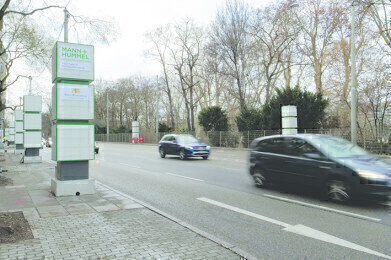Air Clean Up
Filter Cubes at the Neckartor traffic junction in Stuttgart now also reduce concentration of nitrogen dioxide
May 06 2019
The 17 Filter Cubes III from MANN+HUMMEL installed at the Neckartor traffic junction in Stuttgart are being retrofitted with technology which now reduces the concentration of nitrogen dioxide in addition to fine dust particles. In the past, the limit value for nitrogen dioxide was regularly exceeded at the "Am Neckartor" measuring station. In February, the filtration specialist had presented the technology for the reduction of nitrogen dioxide (NO2) at polluted locations at its company headquarters in Ludwigsburg. The innovation makes a contribution to protect human health and could remove the need for driving bans in inner cities. The Filter Cubes III from MANN+HUMMEL were installed at the Neckartor traffic junction at the end of last year to reduce fine dust pollution. The assessments made so far have shown that the filters could help to reduce the local concentration of dust particles by between 10 to 30%.
Equipped with a newly developed combifilter medium from MANN+HUMMEL, the Filter Cubes III at the Neckartor traffic junction in Stuttgart now retain nitrogen dioxide from the ambient air in addition to fine dust. The retrofit in question is a temporary solution to reduce the concentration of nitrogen dioxide as quickly as possible. In August, all 17 Fiter Cubes III will be replaced by further developed systems with a larger filter surface area and more powerful fans. In addition, MANN+HUMMEL will increase the total number of installations from 17 to 23. These measures will increase the impact compared to the temporary solution.
MANN+HUMMEL expects that the use of the filter cubes will lead to a reduction of between 10 to 30% for the local concentration of fine dust and also nitrogen dioxide. This corresponds to 40% of all the nitrogen dioxide and fine dust emissions which are generated by vehicles passing by the Neckartor traffic junction in Stuttgart. In the past, the limit value for nitrogen dioxide (40 micrograms per cubic meter on average throughout the year) was regularly exceeded at the "Am Neckartor" measuring station.
Less nitrogen dioxide through use of activated carbon
The newly developed combifilter includes a filter layer that retains particles and additional activated carbon layers to adsorb nitrogen dioxide. In this process, highly porous activated carbon media are used, and due to their large surface area, are able to efficiently absorb nitrogen dioxide. The pollutants are retained using a number of different processes, e.g. physical adsorption, chemical binding and catalytic reduction.
The technology is characterised by a particularly low drop in pressure. As a result, it is able to efficiently clean the air while using a low amount of energy. The Filter Cubes include combifilters and also fans to draw in the ambient air. The filters are able to bind more than 80% of the nitrogen dioxide and fine dust contained in the ambient air that is drawn in. Control electronics allow the user to adapt the operation of the filters to match operating conditions and therefore react to the current air quality. Sensors record air and weather data which are transferred to a cloud and analysed.
Events
May 05 2024 Seville, Spain
May 13 2024 Munich, Germany
May 23 2024 Beijing, China
May 23 2024 Beijing, China
Jun 10 2024 Algiers, Algeria

.jpg)













